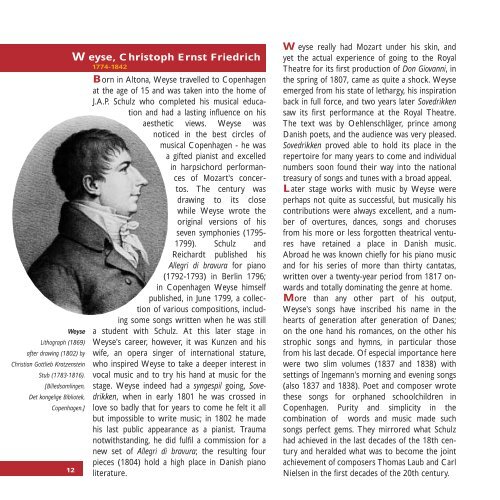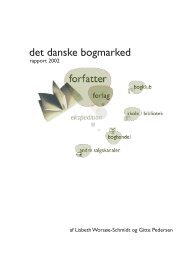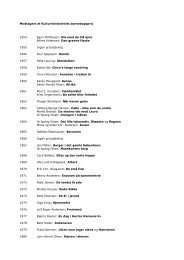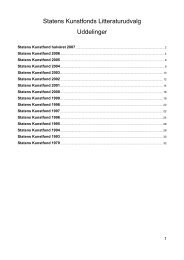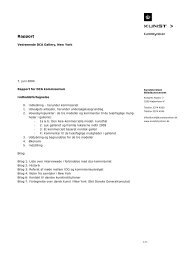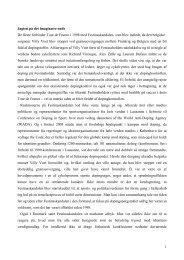Danish Music: The Golden Age 1800-1850
Danish Music: The Golden Age 1800-1850
Danish Music: The Golden Age 1800-1850
Create successful ePaper yourself
Turn your PDF publications into a flip-book with our unique Google optimized e-Paper software.
Weyse<br />
Lithograph (1869)<br />
after drawing (1802) by<br />
Christian Gottlieb Kratzenstein<br />
Stub (1783-1816).<br />
[Billedsamlingen,<br />
Det kongelige Bibliotek,<br />
Copenhagen.]<br />
12<br />
Weyse, Christoph Ernst Friedrich<br />
1774-1842<br />
Born in Altona, Weyse travelled to Copenhagen<br />
at the age of 15 and was taken into the home of<br />
J.A.P. Schulz who completed his musical education<br />
and had a lasting influence on his<br />
aesthetic views. Weyse was<br />
noticed in the best circles of<br />
musical Copenhagen - he was<br />
a gifted pianist and excelled<br />
in harpsichord performances<br />
of Mozart's concertos.<br />
<strong>The</strong> century was<br />
drawing to its close<br />
while Weyse wrote the<br />
original versions of his<br />
seven symphonies (1795-<br />
1799). Schulz and<br />
Reichardt published his<br />
Allegri di bravura for piano<br />
(1792-1793) in Berlin 1796;<br />
in Copenhagen Weyse himself<br />
published, in June 1799, a collection<br />
of various compositions, including<br />
some songs written when he was still<br />
a student with Schulz. At this later stage in<br />
Weyse's career, however, it was Kunzen and his<br />
wife, an opera singer of international stature,<br />
who inspired Weyse to take a deeper interest in<br />
vocal music and to try his hand at music for the<br />
stage. Weyse indeed had a syngespil going, Sovedrikken,<br />
when in early 1801 he was crossed in<br />
love so badly that for years to come he felt it all<br />
but impossible to write music; in 1802 he made<br />
his last public appearance as a pianist. Trauma<br />
notwithstanding, he did fulfil a commission for a<br />
new set of Allegri di bravura; the resulting four<br />
pieces (1804) hold a high place in <strong>Danish</strong> piano<br />
literature.<br />
Weyse really had Mozart under his skin, and<br />
yet the actual experience of going to the Royal<br />
<strong>The</strong>atre for its first production of Don Giovanni, in<br />
the spring of 1807, came as quite a shock. Weyse<br />
emerged from his state of lethargy, his inspiration<br />
back in full force, and two years later Sovedrikken<br />
saw its first performance at the Royal <strong>The</strong>atre.<br />
<strong>The</strong> text was by Oehlenschläger, prince among<br />
<strong>Danish</strong> poets, and the audience was very pleased.<br />
Sovedrikken proved able to hold its place in the<br />
repertoire for many years to come and individual<br />
numbers soon found their way into the national<br />
treasury of songs and tunes with a broad appeal.<br />
Later stage works with music by Weyse were<br />
perhaps not quite as successful, but musically his<br />
contributions were always excellent, and a number<br />
of overtures, dances, songs and choruses<br />
from his more or less forgotten theatrical ventures<br />
have retained a place in <strong>Danish</strong> music.<br />
Abroad he was known chiefly for his piano music<br />
and for his series of more than thirty cantatas,<br />
written over a twenty-year period from 1817 onwards<br />
and totally dominating the genre at home.<br />
More than any other part of his output,<br />
Weyse's songs have inscribed his name in the<br />
hearts of generation after generation of Danes;<br />
on the one hand his romances, on the other his<br />
strophic songs and hymns, in particular those<br />
from his last decade. Of especial importance here<br />
were two slim volumes (1837 and 1838) with<br />
settings of Ingemann's morning and evening songs<br />
(also 1837 and 1838). Poet and composer wrote<br />
these songs for orphaned schoolchildren in<br />
Copenhagen. Purity and simplicity in the<br />
combination of words and music made such<br />
songs perfect gems. <strong>The</strong>y mirrored what Schulz<br />
had achieved in the last decades of the 18th century<br />
and heralded what was to become the joint<br />
achievement of composers Thomas Laub and Carl<br />
Nielsen in the first decades of the 20th century.


